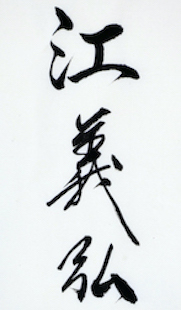
Among Japanese smiths of every era, three are always considered special, due to their unsurpassed skills and incomparable works. They are called “Nihon Sansaku” (日本三作)—“Three Japanese smiths”—a term that appeared in Toyotomi Hideyoshi’s days [There is another one interpretation: Tenka Sansaku (天下三作), the "Three Greatest Masters under the Heaven,"]. The names of these smiths are Gorō Nyūdō Masamune (五郎入道正宗), Awataguchi Yoshimitsu (粟田口吉光), and Gō (no) Yoshihiro (江義弘). They are considered the greatest not only because they were the most accomplished masters of all time, but also because many generations of smiths, inspired by their creativity, sought to reproduce the features and styles of these grand masters’ works.
The “Nihon Sansaku’s” influence and authority were so great that daimyō tried, by any means possible, to obtain for their collections at least one sword forged by these masters. Their works became the ultimate and most desirable offerings and gifts for the shōgun, imperial family members, temples and also to exchange between daimyō.
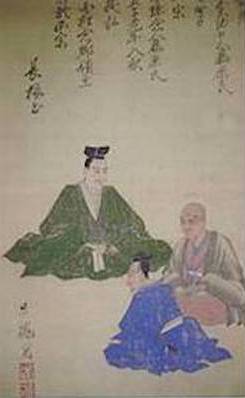
Figure 1. “Nihon Sansaku”, an allegoric picture.
According to the Kotō Meizukushi Taizen, Gō Yoshihiro was 21 years old during the Gen’ō era (元応, 1319–1321). He was born in the 1st year of the Shōan era (正安, 1299) and died in the 27th year of his life in the 2nd year of the Shōchū era (正中, 1325). The same book, as well as the Ōseki Shō (reprint, 1978, p. 92), reports that he was named Umanosuke (右馬允) at birth, was born in the Matsukura-Gō (松倉郷) region in Etchū Province (越中), and, therefore, got the nickname Matsukura-Gō, or simply Gō (江). The “Gō” kanji is usually written as “郷” (in modern sources) and as “江” (in old sources). Concerning Yoshihiro, the more correct, classic written variant is the second one. A slight clarification should be made regarding the master’s (first) name, which is sometimes pronounced “Umanojō” (instead of “Umanosuke,” having the common variant of the inscription 右馬允). It is written using the same characters, and the difference arises from different ways of reading the 允 kanji aloud, depending on whether it was a Chinese or Japanese transcription. (Most Japanese kanji were adopted from the Chinese language.) This is an archaic form of the name, based on the honorary title “Uma no Suke,” where “Suke” meant “assistant.” The pronunciation of the kanji 允 could have changed to “Jō” when read aloud in its Chinese transcription. Nowadays, unfortunately, it is impossible to determine exactly how the proper name of Yoshihiro sounded in the past.
The smith name of Gō Yoshihiro is almost always pronounced along with a short version of his nickname: “Gō.” For the sake of impartiality, it should be noted that all books without exception say that Gō’s birthplace was the Matsukura district. However, no one has an exact idea where this was because there was no district with such a name in those days. Old chronicles mention a small mountain village with this name in the Shimoniikawa (下新川) district, but it was located very far away, in a hard-to-reach place. Later, the Matsukura (松倉) castle was built next to it and was most likely was named after this settlement.
In fact, it seems probable that the nickname—and, therefore, the so-called second name of Yoshihiro—was not taken from the specific name of some settlement but was derived from the word “Gō”, which simply means “district,” “village,” or “province.” That is to say, why, since he was born in Matsukura, was his name not Matsukura Yoshihiro or one of its variations? Almost all authors carefully conceal this illogical fact when explaining the formation of the master’s nickname. They usually say that the long name lost its semantic meaning and only “Gō” has survived.
Uchida Soten (内田疎天) offers a very interesting and noteworthy explanation of this. He draws attention to the fact that the alleged birthplace of Yoshihiro, Matsukura village, was located four miles away from the modern city of Uozu (魚津), Toyama Prefecture. At a distance of just one mile from Matsukura was a fairly well-known river: Hayatsuki (早月). Very often in Japanese poetry, instead of the usual “Kawa” (川) kanji to denote a river, the “Ka” (河) kanji was used, which, as we can see, is very similar to the written “Gō” (江) kanji. In addition, the 河 kanji can be read both as “Gō” and “Ga,” contributing to possible confusion in calligraphy written in old books. Therefore, it is quite possible, and even likely, that the name “Gō Yoshihiro” could more correctly be interpreted as “Yoshihiro from the river (Hayatsuki).”
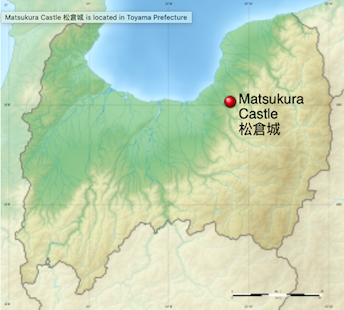
Another well-known fact mentioned in every text about Gō Yoshihiro is that he was a samurai in the service of the Momoi (桃井) clan. A little later, the clan took the above-mentioned Matsukura castle under its control. However, the construction of this castle was not completed until 1335. Therefore, in Gō Yoshihiro’s era, there simply was no castle, although this information gives us an idea of where Gō likely started his service. Along with sword mastery, in his early childhood he was interested in smithing and began to study this skill. Similar to the murky origins of Norishige’s smith name, the derivation of Yoshihiro’s smith name is unknown. Neither do we know the master who began to teach Yoshihiro. There is also no historical information about which names he used as the basis of the kanji in his smith name. Proceeding from an analysis of his early works, we can consider it likely that he began his training with Yamato-style smithing. The influence of this school is clearly traceable in his works, especially in the early period of his creative activity.
Figure 2. Ruins of Matsukura Castle.
There is no doubt that Gō Yoshihiro was in a close relationship with another great master, Etchū Norishige, a native of the same area as Gō. Some sources indicate that the Momoi clan often ordered Norishige to make its swords. The chronicles claim that after the death of Gō, his son Tametsugu became the adopted son of Norishige and later learned the art of smithing from him. These facts confirm the close relationship between Gō and Norishige, as well as that the two masters had a strong influence on each other’s creative perspective. In Gō’s works, the influence of Norishige’s style is notable; it can most often be seen in the similar structure of their kitae.
After Norishige went to Sagami, Gō Yoshihiro followed him there to continue his education in smithing. The fact that Gō also trained under Masamune is confirmed by old sources, such as the Kokon Meizukushi Taizen. Gō Yoshihiro is considered the best of the “Masamune no Jittetsu,” equal to his teacher’s talent. On this point, there is no argument from experts. Yet the rest of Gō Yoshihiro’s life is shrouded in mystery and contradictions. The overwhelming majority of connoisseurs think that Gō Yoshihiro died in 1325 at the very young age of 27 and that he might have surpassed Masamune in skill, if he had lived longer. These experts think that possibly his death was related to his samurai duties with the Momoi clan and occurred during a battle. Modern authors base these ideas on books written in the seventeenth and eighteenth centuries, whose authors used even more ancient books as their sources. However, very old chronicles provide no evidence of this early death. One problem with ancient sources is their fragmentary information, so we have no way of telling whether parts of these books were damaged or illegible or simply lacked details in certain areas. Moreover, statements about Gō Yoshihiro’s premature death might have been purposely spread by the Hon’ami family.
It is no secret that the Hon’ami family members played a very significant role in the emergence of the name Masamune (see the “Masamune” chapter). It seems that they were also involved in regard to Gō Yoshihiro, although the existence of this master is indisputable. Through their in-depth study, emphasis, and popularization of Gō Yoshihiro, the best representatives of the Hon’ami family provided a magnificent and sometimes ingenious appreciation for, and deep understanding of, masterpieces of Japanese sword making. The predominant merit of the Hon’ami representatives is that in the case of Gō, from a huge mass of swords they were able to single out works with such basic characteristics that, in their totality, these could not be attributed to any other smiths. Their distinctive features make it absolutely clear that these works were created by one unique master. However, it seems that in popularizing Gō Yoshihiro’s legend and promoting his genius, they went too far and invented a little additional tale about his death at an early age. In keeping with their plan, this tragic accident would only serve to emphasize his bright talent and create a romantic halo around him.
If we consider it in more detail, this version of Gō Yoshihiro’s early death appears very doubtful, and the following facts provide evidence against it:
1. Among Gō’s followers, there were two fully trained sons: Yoshihiro (義廣, or 義弘) and Tametsugu (為継), as well as his adopted son Yoshizane (義真) and a disciple, Tametsugu (為次). In addition, he managed to teach Norishige. To do this, he had to be a mature and experienced master. All of this would have been impossible if he had not lived long enough to accomplish these things.
2. Currently, there is an extant detailed description of eleven of Gō’s meibutsu, which are authentic masterpieces and works of unsurpassed quality. All these works prove that he was a mature and qualified master. Usually, a master was able to create works with this degree of excellence only after the age of forty.
3. The Hon’ami clan’s participation in promoting Gō as an unsurpassed master can be traced in almost all his famous works. For example, the “Kitano Gō” was originally purchased by Hon’ami Kōsa and Hon’ami Kōeki in Sakai, and Hon’ami Kōtoku rated it at 1,500 kan; the “Samidare Gō” was found by Hon’ami Kōsa and re-polished, and then Hon’ami Kōshitsu changed its attribution from Uda to Gō Yoshihiro; the “Dai Gō” was bought by Oda Nobunaga through the intermediary negotiations of Hon’ami Kōji; and the “Uesugi Gō” was discovered and bought by Hon’ami Kōho. Surely, we can add more items to this list, as well as supplement it with the Hon’ami family’s participation in evaluating the swords and writing kinzōgan-mei on almost all of Gō’s works.
4. An analysis of data provided in old sources makes it possible for us to conclude that before the Keichō era (慶長, 1596–1615), there was no information on the early death of Gō Yoshihiro. The first time that details of this type appeared was during the period when the Hon’ami family actively began to create the persona of Gō as a phenomenon who went beyond the ordinary.
5. Many sources, such as the Kokon Kaji Bikō (1830, Volume 2, p. 46/1), postulate that Gō Yoshihiro was a Momoi clan vassal during the Kenmu era (建武, 1334–1338). At this time, the Matsukura castle had already been built and was already under clan members’ control. The clan ordered swords from Yoshihiro and greatly appreciated his skills. After that (obviously, after Kenmu), he was taught by Masamune in Kamakura, and once he completed his education, he returned to Etchū. It can be noted that this source describes a completely ordinary—in terms of duration—life of a smith without any hint of death at an early age.
Thus, it is entirely possible that Gō Yoshihiro lived a long and fruitful life, which lasted at least until the Jōwa era (貞和, 1345–1350). Indirect confirmation of this version could be found in the Ōseki Shō (reprint 1978, p. 92). It is reported that Gō after the completion of training with Masamune returned to his native province of Etchū. Yet this does not diminish his merits as a brilliant master and one of the most illustrious smiths who worked in the Sōshū style.
We can find two main misconceptions about Gō Yoshihiro’s works in many modern descriptions of his creative output. The first misconception concerns the signature on his works. The second one is that the master never made tantō.
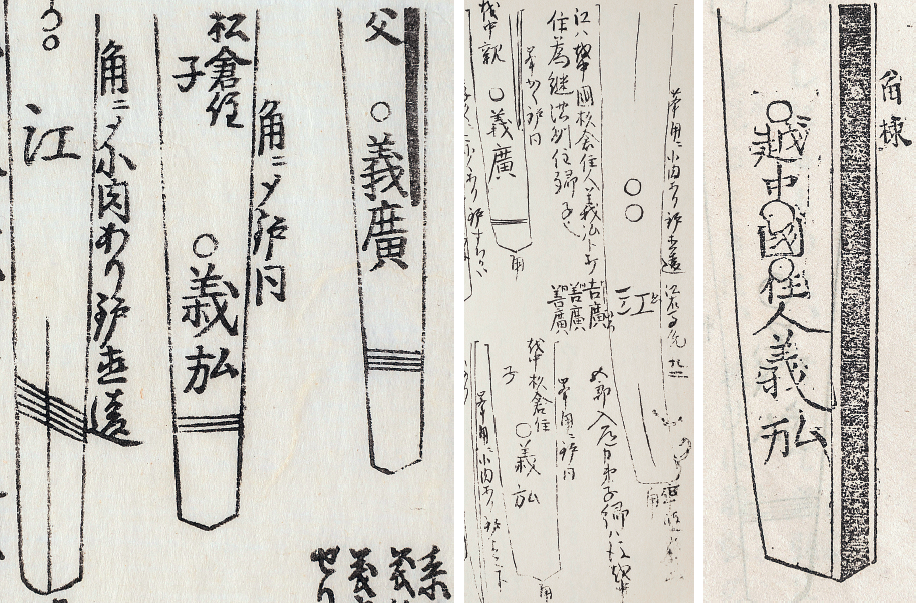
Figure 3. Gō Yoshihiro’s signature variants. Kokon Wakan Banpō Zensho, Volume 12 (3), p. 114; Ōseki Shō, reprint 1978, p. 92; Tōken Kantei Hikketsu, Hon’ami Yasaburō, 1905, Volume 3, p. 129.
As for the signature, we often encounter a statement claiming that Yoshihiro never signed his swords at all. Here, we should recall that a similar assertion was made for both Masamune and Sadamune and very much resembles the experts’ standard attempt to find the easiest explanation for the absence of signed works. At present, of course, it is impossible to completely refute this statement. Among extant swords attributed as Gō’s works, not one has Gō’s signature. Nevertheless, when we answer this question, we must take into account both the small number of this master’s extant works and the fact that all long swords were shortened and there are no more works with ubu nakago (in their original form). Yet it is impossible for us to agree with the statement that Gō never signed his works. Most likely, all extant swords that can be attributed to Gō have lost their signature after shortening. This is indirectly confirmed by the preserved oshigata in old sources that show variants of the master’s signatures, despite the fact that there is no complete certainty and clarity regarding their authenticity.
Many old sources, such as the Ōseki Shō (往昔抄) and the Kokon Meizukushi Taizen (古今銘尽大全), provide three different versions of the master’s signature on long swords. For example, quoting Kokon Wakan Banpō Zensho (古今和漢万寶全書, 1694, Volume 12 [3], p. 114), they can be listed as follows:
- The first option is niji-mei, 義廣; it is believed that this signing method was used when Gō was working in Kamakura;
- The second option is niji-mei, too, but with a different second kanji—義弘. This method of signing was used during the master’s stay in Etchū Province, both initially and after he returned from Kamakura;
- The third option is the signature with one “Gō” kanji—江. It was used during his work in Etchū.
In this case, it is necessary to pay attention to the peculiarities of writing the “Hiro” kanji, 弘, in the second variant of the signature and also to notice that the first two nakago have the kengyō (剣形) type of tip (see the Figure 10.1). In addition, sometimes we find the second variant of the signature with an alternate written form of the “Yoshi” kanji, 善, which could also have been used by the master. All three versions have the signature located near the center of the nakago under the first mekugi-ana. As for the dating of Gō Yoshihiro’s works, there are no extant sources indicating that he put dates of manufacture on his works. It is possible that the master never dated them at all.
The variant of the signature with one “Gō” (江) kanji, if the oshigata reproduced an actual sword, does not raise doubts about its being made by Gō Yoshihiro. Regarding the other two variants of niji-mei, we should note that they are both believed to belong to Senjū’in Yoshihiro (千手院義弘), who also signed his works with two 義弘 kanji. In relation to him, there are suggestions that he was Gō’s son or even that he was the same smith. We should emphasize that there are extant works by Senjū’in Yoshihiro dated with the Jōwa (1345–1350) and Bunna (1352–1356) eras.
<.....> So far, the most consistent, albeit the most questionable, explanation is that these masters signed their works if they wanted to and did not bind themselves to strict rules on this matter. Most likely, in reality, there was also another, more weighty reason, which resulted in a very large number of unsigned tantō in the Sagami School. The works attributed to Gō Yoshihiro only add more puzzles to this unresolved question, and if we could answer it, we could better understand the events that took place in Kamakura at that time. Moreover, this open question, in general, casts doubt on the explanation that long swords lacked signatures only because they all were shortened during their lifetime. Taking into account the facts we know about tantō, as well as the possibility of preserving signatures using the gaku-mei or orikaeshi-mei methods, this explanation seems too simplistic. It clearly needs further research and another, more detailed resolution.
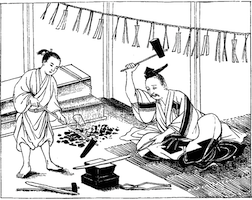
Gō Yoshihiro’s works have the following main characteristics:
Sugata: The tachi are made in the style typical for the end of the Kamakura period and are generally characterized by the following: hira-zukuri with mitsu-mune, a broad mihaba, a relatively thick kasane, a small sori (more often, toriizori), and the presence of hira-niku (a small degree of slope between the habuchi and the shinogi line). Since all swords are greatly shortened, it is very difficult to precisely imagine their original shape.
Kissaki: This was often made in a form close to ikubi-kissaki, though it was somewhat less round in shape in the fukura area, as compared to the classical one. Ō-kissaki is rare.
Jitetsu: This shows very distinct grains of the so-called Awataguchi hada, but in comparison with that, these are denser and cleaner. In the early period, we can find mokume-hada mixed with ō-hada; however, ko-itame is considered classic. It has a large number of ji-nie, forming chikei and yubashiri. One important characteristic is the manifestation of the “wet steel” effect, which in Gō’s works is very pronounced. The color of steel in the ji area is blackish with a bluish-purple hue.
Hamon: Most often, ko-notare alternating with elements of a shallow midare; there is a mix of gunome and ko-midare; often there are elements of suguha-chōji. Very often, the hamon line rises up to the shinogi in the monouchi area and runs into bōshi with a “raised” level of hardening, which is Gō’s hallmark. The nioiguchi line is clean and bright, with deep and luminous nioi and kinsuji. There are also numerous inclusions of nie, as well as “frayed” areas of kuzure and areas with long and deep ashi, inazuma, and kinsuji. The works feature unusual depth and brightness of nie. The color of steel in the ha area is bluish with a slight whitish hue.
Bōshi: The bōshi are made with very great skill, the nie is very deep, and the tempering line is usually high in the ko-maru style, with a deep kaeri. Hardening of the ichimai (一枚) type—that is, a fully tempered kissaki—occurs very often. Frequently, the kaeri line goes behind the yokote and captures a small part of the mune. Sometimes there is hakikake.
Horimono: A bō-hi is very rare and in general barely reaches the kissaki and ends with a rounded curve.
Nakago: According to the old books, the original tang was performed in the form of sotoba (卒塔—tang in the form of a grave stele, almost without taper and with a pointed tip). Currently, all nakago are very much shortened and, as a result, not signed. Many of them have kinzōgan-mei. Shortening of the nakago by the kengyō type is typical, but there are also kurijiri and kiri. Many of them have kiri yasurime or katte-sagare yasurime toward the tip, but most likely, all extant yasurime are attempts to restore the previously existing cut part of the nakago, and the original yasurime was not preserved on any sword.

Figure 4. Norishige and Gō Yoshihiro's elements of activity layout. Kokon Meizukushi Taizen, vol. 5, p. 19/1.
(excerpt from Chapter 10, pp. 254-273, of the Japanese Swords: Sōshū-den Masterpieces )
Original content Copyright © 2019 Dmitry Pechalov